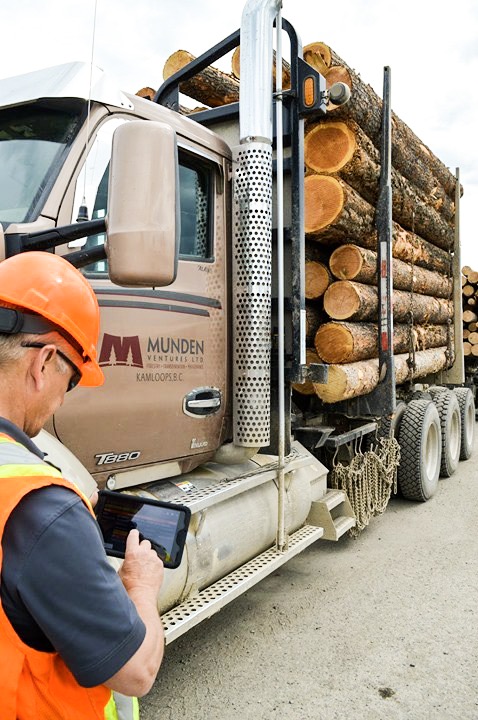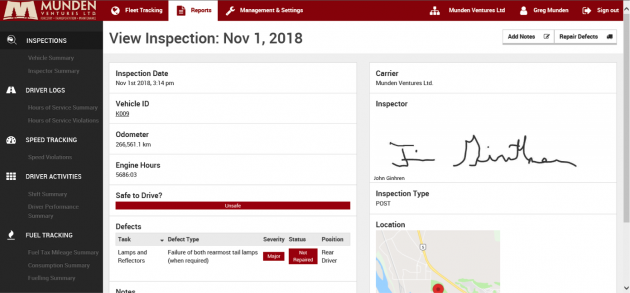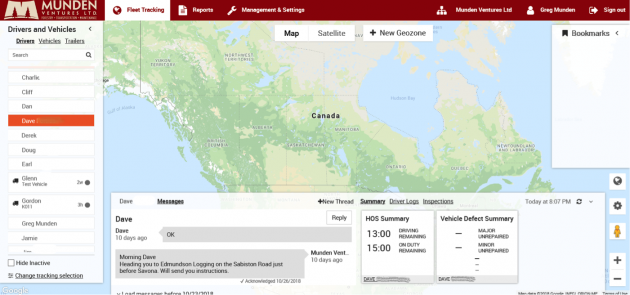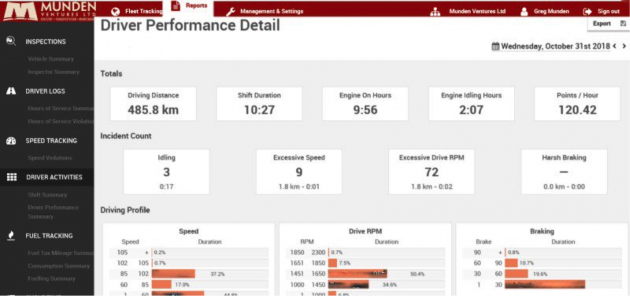
Features
Harvesting
Transportation
A contractor’s guide to electronic logging devices: Part 2
July 26, 2019 By Greg Munden
 The road to ELD/telematics implementation is not without its challenges, but the rewards will quickly outweigh the costs. Photo courtesy Munden Ventures.
The road to ELD/telematics implementation is not without its challenges, but the rewards will quickly outweigh the costs. Photo courtesy Munden Ventures. Editor’s note: this is the second of a two-part series by Kamloops, B.C., log hauler and logging contractor Greg Munden, sharing his company’s experience implementing electronic logging devices (ELDs). Read part 1 here covering the differences between ELDs and electronic onboard recording devices (EORBs), the operational realities of moving to ELDs, and software and hardware suppliers.
By now you’ve likely assessed your business’ ability to comply with hours of service regulations and made operational changes to ensure you can. You’ve decided what type of solution is right for you (ELDs versus EORBs), and researched and selected a software and hardware provider. The next step is to prepare your company to implement that solution.
Buy-in from your drivers and how you go about transitioning to an ELD (also known as ELOG) world is crucial. Most of the industry is already grappling with a driver shortage – the last thing any of us want to do is make that worse by implementing something that your drivers won’t accept. Having an informational meeting with your drivers early on is an imperative first step.
Drivers are mostly concerned about how these devices will impact their lives. We have an aging demographic and many of our older drivers are simply resistant to change, particularly when that change includes technology they may be uncomfortable with. This goes back to the importance of simplicity when it comes to the ELD component of your system (read Part 1).
A good method to help with buy-in is to find an internal champion. Most of us have a couple of drivers who are technology savvy and need to have the latest gadgets. (Pick the ones who stand in line at Best Buy for the latest iPhone release.) Meet with them separately and solicit their help in the implementation process.
Work closely with them both before and after system install to see how they are doing with the system and to help them solve any problems early on. Make sure you have supplier support ready to assist in working through the challenges that will inevitably come up.
We involved the local provincial vehicle enforcement manager in our decision to transition to ELDs. We kept him apprised of what we were doing and we asked him for a transition period, whereby we would have our drivers train on the ELD system, but continue to use their manual paper logbook as their official logbook. Our manager provided us with a letter to carry in each of the trucks authorizing this so as to avoid anyone charging us with running two logbooks during this training period. This way, our early days of ELD use were much less stressful for our drivers.
Once your champion drivers are comfortable with the system, include them in group driver training sessions to begin transitioning your larger driver pool. Make sure your ELD provider has the capability and resources to provide classroom-style training at your facility, with a demonstration system that can emulate what the drivers will see in their trucks. And make sure you have included this driver training in your agreement with your chosen supplier.
Include key operational people in all driver training. These operational people will need additional training to know how to use the back-office aspects of the software, such as setting up new power units and trailers, adding employees, assigning user IDs and rights, pulling information from the system, as well as telematics data if you choose that capability.
Maybe most importantly: have patience. In our experience, the technology is best used as a learning tool to allow your company and your drivers to improve, not as a stick to easily identify all of their shortcomings.
Harnessing the ELD/telematics system
There are some key features that, in our experience, are must-haves when it comes to an ELD solution:
Exception reporting: One of the great advantages from a management perspective with electronics is the ability for the system to weed out the less useful data from the data that needs your attention. With ELDs, the only logbooks that are critically important are the ones that don’t comply with hours-of-service regulations. A good ELD software package will bring those logbooks to your attention so that you don’t have to seek them out. This is a huge management time saver.
Pre/post trip inspections: Strong ELD solutions incorporate a robust pre/post trip reporting capability with the software. Remember, our goal is do away with the paper logbook and anything that goes along with it, including the vehicle inspection reports. Your ELD system should allow drivers to complete their daily vehicle inspections online, within the system. Once again, units that are inspected that have defects should be easily identified by the system without your maintenance department having to look hard to find them.

A good ELD solution incorporates a robust pre/post trip reporting capability with the software.
Hours of service reporting: Your ELD system needs to have an easy way for both management and drivers to access previous days’ logbooks, both for personal use and for the provincial regulator, if required. Understanding how long your ELD provider stores this information is important, both practically and legally. Logbooks must be maintained for viewing for six months for regulator purposes. If you use logbooks as a means for calculating payroll, they may be needed for seven years.
Personal information storage: Knowing where the personal information for your business and, most importantly, for your drivers is stored is very important. Do your homework here, but you may be contravening your employees’ personal information rights if their ELD information is stored outside of Canada.
Fleet tracking and two-way communication: We’re straddling the fence here on whether this is an ELD solution or an EOBR solution. Regardless, if you are only opting for an ELD solution, having the capability to track your vehicles on a map in your back-office and having two-way communication via text from the office to your drivers and back through your onboard system is a huge asset.

An example of two-way communication.
Logbook editing: ELD systems must still include the ability for the driver to edit his logbook if a mistake is made. There are very specific requirements about how an electronic logbook can be edited and what can be edited (for instance, it is believed that the final ruling will not allow for the editing of “on-duty driving” time). Compliant ELD systems must have an audit trail built into them to highlight anything within a logbook that has been edited, and by whom. For example, early in our implementation we regularly had drivers forget to log off at the end of their shift, leaving themselves “on-duty not driving” for their entire off-duty time while they were at home. An inability to edit the logbook would have meant they couldn’t go to work the next day.
Telematics features and capabilities
If you’ve made the decision to go with a full-feature ELD/EOBR system, you’ll want to extract all of the telematics information available to help streamline your operations. These are some of the features and capabilities that we use and highly recommend.
Driver scorecard: One of the great features of modern day EOBR systems is the ability to set parameters around how you want your trucks operated, and provide regular and ongoing feedback to your drivers. Once again, it’s all in the approach. The minute drivers feel like these systems are being used as a stick over them, all is probably lost. Your drivers will feel suspicious and it may not be long before they are looking for another driving opportunity with someone else – and there are plenty of them out there.
Things you might consider setting targets around include speed, idle time, harsh braking, and target rpm under braking and under power. A driver scorecard can be created to provide points throughout your drivers’ day for staying within your parameters, and have points deducted for straying outside of those parameters. At the end of the day, the driver (and company) can receive a report showing his performance for the day.
If you approach this as a learning tool, and your targets as goals for your drivers to reach for, it should be well received by your driving team. Tying this to an incentive program for safety and efficiency is the next step to share the savings with your driving team.

An example of a driver’s scorecard.
Fuel usage: EOBR’s provide an easy way to monitor, compare and report on fleet, individual unit and driver fuel usage. Tying the monitoring of fuel usage to establish speed targets, idle-time targets and driver scorecards can be a very powerful tool in moving your company to meaningful fuel savings. As well, reporting on fuel usage within different jurisdictions will make IFTA tax claims that much easier to submit.
Idle-time monitoring: Creating fleet and individual trip targets for idle time is a great way to reduce fuel consumption and cost, and minimize the maintenance costs, which inevitably rise with high idle time – particularly with current after-treatment systems – all while helping the environment.
Cycle-time calculating: Advanced telematics systems have the ability to extract data on cycle times for individual hauls. Depending on the complexity of your operation, some systems can automatically calculate cycles (for repeat and routine routes), or allow you to build cycle routes by stringing together geo-zones.
Geo-fencing: Geo-fencing allows you to essentially put a box around a particular segment of your route, or your entire route, name it and then put particular criteria within that geo-zone. For instance, maybe you have a particularly dangerous corner along your route that is the scene of many accidents and you want your equipment travelling 40 km/ hour around that corner. You can geo-fence that corner along your route, and set your maximum speed at 40 km/hour, even if the actual legal speed limit is 60 km/hour. Drivers will be cautioned if their speed is above 40, as will the company depending on the settings you choose.
This type of tool can also be used to identify school zones or other high-risk areas. You might also use it to geo-fence a customer’s property, which will allow you to later pull reports on how long your equipment is at a customer site being loaded or unloaded – a great way to have the data you need to support rate negotiations, or, even better, support customer conversations to improve the service for your drivers and company while on their site.
Speed monitoring: Some telematics systems may only allow you to choose a company maximum speed, whereby it only reports speeds in excess of that single max speed limit. More advanced systems have the capability of recognizing the speed limits on all major road systems. These systems will allow you to set a tolerance on the legal speed limit, and then report any violations at any speed beyond the tolerance you have set.
Messaging: Two-way messaging between your home office and trucks is a great tool. This allows drivers to put away their phones and receive messages through their onboard system whenever they are at the next safe place to view them, which can improve safety, reduce the impulse for drivers to talk or text while driving (telematics systems should prevent driver input while the vehicle is in motion), and improve operational efficiencies in dispatching equipment.
Fleet tracking: Fleet tracking is a tool that should be included in all telematics systems (and often in your base ELD system). Simply put, this is the ability to view all of your equipment, real-time, on your computer screen, over-laid on a map. Hovering over each unit will often provide additional information, like whether the truck is empty or loaded, the current speed, truck and trailer numbers, and the driver’s name and duty status.
Fleet tracking can provide customer’s with accurate information on arrival times, etc., without needing to contact your driver.
This is certainly not an exhaustive list of features available with a telematics system, but it does represent ones we think you should consider looking for in any package. Other options like engine fault code reporting, breadcrumb tracking and reporting, and so on, are all available depending on your choice of system.
The road to ELD/telematics implementation will not be one without its challenges, but the rewards will quickly outweigh the costs. The sooner you get started, the more smoothly the transition will go, and the more time you will have to onboard your staff in a positive way.
Best of luck as you pick your path to ELD and telematics implementation.
Greg Munden is the president of Munden Ventures Ltd., a B.C.-based, fourth-generation log hauling, harvesting and commercial vehicle inspection, repair and maintenance business. Reach Greg at 250-828-2821 or gmunden@mundentrucking.ca.
Print this page